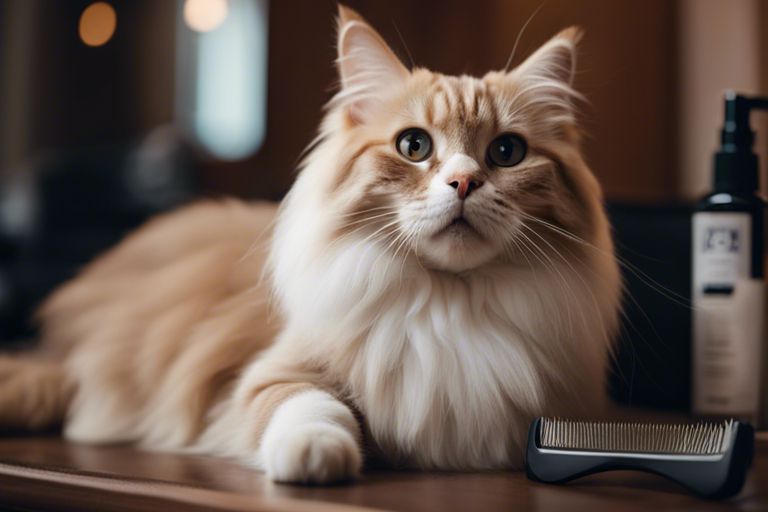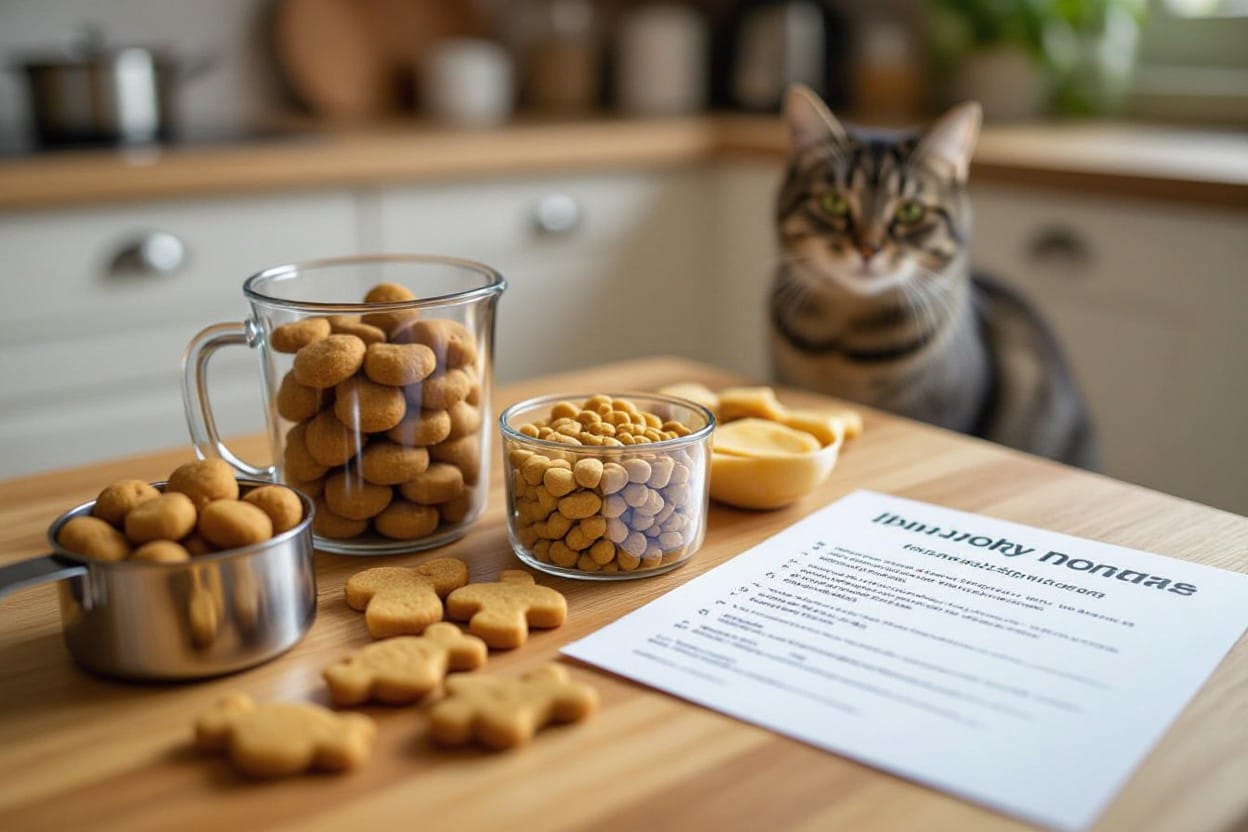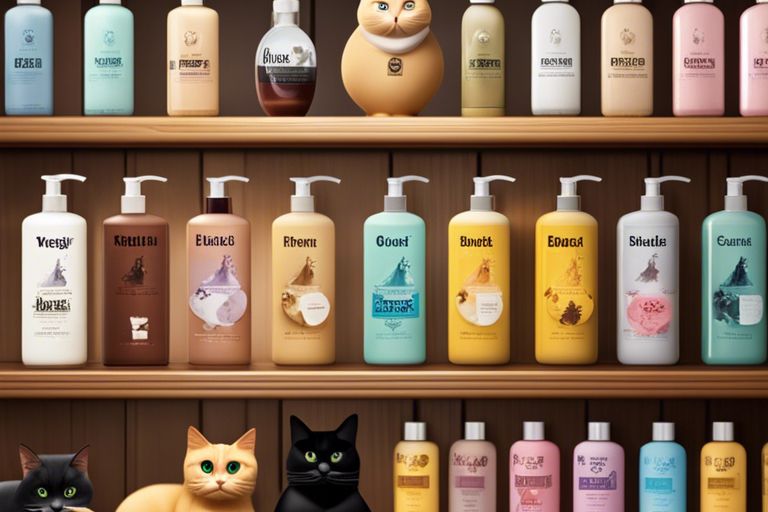Just like humans, cats also need regular grooming to maintain a healthy and shiny coat. A shiny coat not only enhances your cat’s appearance but also signifies good health. In this blog post, we will discuss some crucial tips and tricks to help you keep your feline friend’s coat looking glossy and lustrous.
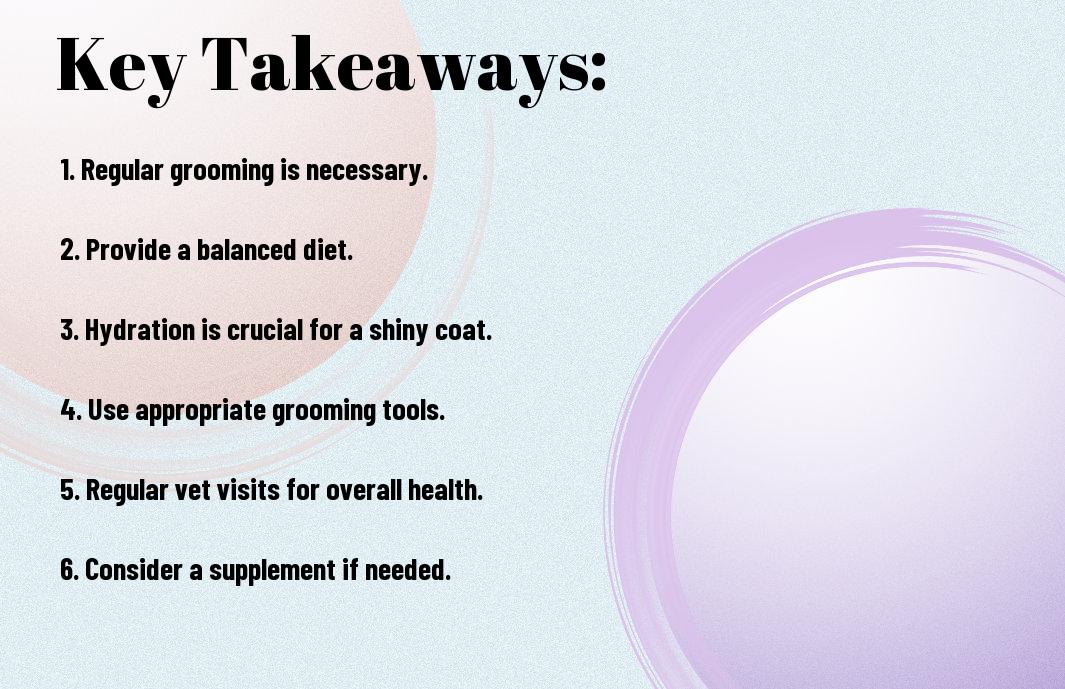
Nutrition for a Shiny Coat
Even with regular grooming, one of the most important factors in maintaining a shiny coat for your feline friend is their diet. Providing your cat with the right nutrients is important for their skin and fur health, which directly impacts the luster and overall appearance of their coat.
Essential Nutrients for Skin and Fur Health
The key nutrients necessary for maintaining healthy skin and a shiny coat in cats include protein, vitamins, and minerals. Proteins are the building blocks for strong, healthy hair, while vitamins such as A and E play a crucial role in promoting skin health. Additionally, minerals like zinc and omega-3 fatty acids are important for maintaining a glossy coat.
The Role of Fatty Acids
Skin and coat health are heavily dependent on fatty acids, particularly omega-3 and omega-6. These important fatty acids play a vital role in nourishing the skin, reducing inflammation, and promoting a shiny, lustrous coat. Omega-3 fatty acids, in particular, are known for their anti-inflammatory properties and ability to improve skin hydration and fur texture.
Recommended Foods and Supplements
When deciding on cat food for a healthy coat, look for options that are rich in high-quality proteins, such as salmon or chicken. These proteins provide the necessary building blocks for strong, shiny fur. Additionally, consider incorporating fish oil supplements into your cat’s diet to boost their intake of omega-3 fatty acids, promoting skin and coat health.
This will not only help in achieving a glossy coat but also support overall skin health, reducing issues such as dryness and irritation.
Grooming Essentials
Effective Brushing Techniques
One of the most important grooming tasks for keeping your cat’s coat shiny is proper brushing. Regular brushing can help remove loose fur, dirt, and prevent mats from forming. Start by gently brushing your cat’s coat in the direction of hair growth, paying close attention to areas prone to tangling, such as behind the ears and under the legs. Be gentle and use a soft brush or comb to avoid irritating your cat’s skin.
Choosing the Right Grooming Tools
For a healthy and shiny coat, it is important to choose the right grooming tools for your cat. Different breeds may require different tools, so it’s important to do some research or consult with your veterinarian or a professional groomer about the best options for your cat’s specific coat type. Some common grooming tools include slicker brushes, bristle brushes, combs, and shedding tools. Investing in high-quality tools can make the grooming process more comfortable for both you and your feline companion.
Techniques such as when and how often to groom your cat, as well as the use of cat-specific grooming products, can also play a significant role in maintaining a shiny coat. Regular grooming not only keeps your cat looking good but also promotes bonding and overall well-being. By incorporating these grooming importants into your routine, you can help your cat stay happy, healthy, and looking their best.
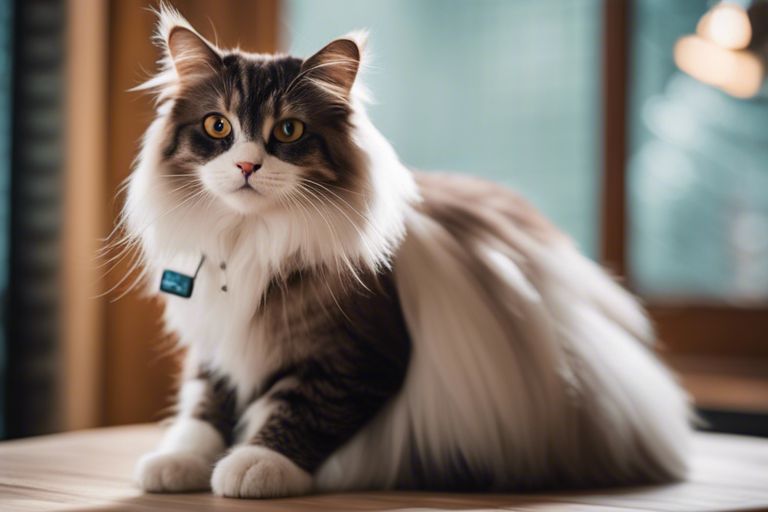
Bathing Your Cat
Deciding When to Bathe Your Cat
Unlike dogs, most cats are able to groom themselves effectively. However, there may be instances where a bath is necessary to maintain your cat’s shiny coat. One common reason for bathing your cat is if they have gotten into something sticky or dirty that they cannot clean off on their own. Another reason could be if your cat has a skin condition that requires medicated shampoo or if they suffer from severe matting that needs to be addressed.
Tips for a Stress-Free Bath
Your cat may not appreciate baths like dogs do, but there are ways to make the experience less stressful for both of you. One vital tip is to gather all your supplies beforehand, such as a cat-friendly shampoo, towels, and a gentle brush. It’s also important to trim your cat’s nails to prevent scratches during the bath. Creating a calm environment by playing soothing music or using pheromone sprays can help relax your cat before and during the bath.
- Use lukewarm water to avoid shocking your cat.
- Speak softly and reassure your cat throughout the process.
Your cat’s comfort and safety should be the top priorities during bath time. Avoid getting water and soap in your cat’s eyes and ears, and be gentle when massaging the shampoo into their coat. Any signs of distress or discomfort should prompt you to stop the bath and try again another time.
- Reward your cat with treats and praise after the bath to help them associate the experience with something positive.
- Regular brushing and grooming can help reduce the frequency of baths needed for your cat.
With patience and the right approach, bathing your cat can become a manageable task that helps maintain their shiny coat and overall well-being. Remember to always consult with your veterinarian if you have any concerns about your cat’s grooming routine or if you notice any changes in their coat or skin health.

Keeping Parasites at Bay
Not only can parasites like fleas and ticks make your cat uncomfortable, but they can also wreak havoc on their coat, causing it to lose its shine. It is crucial to take preventive measures to keep these pesky parasites at bay to ensure your cat’s coat remains healthy and lustrous.
Importance of Flea and Tick Prevention
Importance Fleas and ticks not only cause irritation and discomfort to your cat but can also lead to more severe health issues such as allergies, skin infections, and even diseases. These parasites feed on your cat’s blood and can cause anemia, especially in kittens or older cats. In addition to the physical discomfort, constant scratching and biting can also damage your cat’s coat, making it look dull and unhealthy.
Safe and Effective Parasite Control Methods
To effectively control these parasites, it is vital to use safe and effective preventive measures. Consult your veterinarian to determine the best flea and tick prevention products for your cat. There are various options available, including topical treatments, oral medications, collars, and sprays. Each method has its benefits and considerations, so it’s vital to choose the one that suits your cat’s needs and lifestyle best.
Effective Regular grooming and cleaning of your cat’s living environment can also help in preventing flea and tick infestations. Vacuuming your home frequently, washing your cat’s bedding in hot water, and keeping your outdoor environment tidy can significantly reduce the risk of parasites finding their way onto your cat. Be mindful of, prevention is key when it comes to keeping your cat’s coat shiny and parasite-free.
Managing Shedding and Hairballs
Understanding Natural Shedding Cycles
One of the key factors in maintaining your cat’s shiny coat is understanding their natural shedding cycles. Cats shed their fur as a way of renewing their coat and getting rid of old or damaged hair. This shedding is influenced by various factors such as changes in seasons, temperature, and light exposure.
Regular grooming during shedding periods can help remove loose fur and prevent matting. Additionally, providing a balanced diet rich in crucial nutrients like Omega-3 fatty acids can support healthy skin and coat, reducing excessive shedding.
Strategies for Minimizing Hairball Issues
Understanding your cat’s grooming habits is crucial in managing hairball issues. Cats groom themselves by licking their fur, which can lead to the ingestion of loose hair. Hairballs occur when this ingested hair gathers in your cat’s stomach and forms a mass that they may eventually vomit up.
Issues like hairballs can be minimized by incorporating regular brushing into your cat’s grooming routine. Brushing helps remove loose fur before it can be ingested and also stimulates natural oil production in the skin, promoting a healthier coat. Additionally, providing hairball prevention treats or supplements can aid in reducing hairball formation.
Addressing Skin Conditions and Allergies
Despite our best efforts in maintaining our cat’s coat, they may still encounter skin conditions and allergies that affect the health and shine of their fur. Identifying and addressing these issues promptly is crucial to ensure your feline friend stays happy and healthy.
Identifying Common Skin Problems
Any changes in your cat’s skin or coat should prompt a closer inspection. Common skin problems in cats include dry skin, flakiness, redness, itchiness, bald patches, and scabbing. These symptoms could be indicative of allergies, parasites, infections, or underlying health issues that require attention. Consulting with a veterinarian can help pinpoint the root cause of these problems and determine the appropriate course of action for treatment.
Holistic and Veterinary Approaches to Treatment
Identifying the best treatment approach for your cat’s skin condition or allergy requires a combination of holistic and veterinary care. Holistic approaches may include dietary changes, supplements, and natural remedies to alleviate symptoms and support skin health. On the other hand, veterinary treatments such as medicated shampoos, topical ointments, or oral medications may be necessary for more severe cases or infections. Working closely with your veterinarian to develop a comprehensive treatment plan will ensure the best possible outcome for your cat.
Addressing skin conditions and allergies in your cat requires diligence and a proactive approach. By staying vigilant for any signs of skin problems, seeking prompt veterinary care, and following through with the recommended treatment plan, you can help your feline companion maintain a shiny coat and optimal skin health.
Other Factors Contributing to Coat Health
All cat owners know that a shiny, healthy coat is a sign of a happy and well-cared-for feline companion. While proper grooming and nutrition play significant roles in maintaining your cat’s coat, there are other factors that can impact its health.
The Impact of Stress on Coat Condition
Health experts have long known that stress can have a negative impact on overall well-being, and your cat’s coat is no exception. When a cat is stressed, it can manifest physically in the form of a dull, lackluster coat. Stress can be caused by a variety of factors, including changes in routine, new environments, or conflicts with other pets.
The best way to address stress-related coat issues is to identify and eliminate the source of stress in your cat’s environment. Providing a safe and comfortable space, regular playtime, and plenty of attention can help alleviate stress and improve your cat’s coat condition.
Environmental Influences and Seasonal Changes
Stress, harsh weather conditions, and seasonal changes can also affect your cat’s coat health. Extreme temperatures, humidity levels, and exposure to pollutants in the environment can all impact the condition of your cat’s fur.
Final Words
Presently, by following these imperative tips for keeping your cat’s coat shiny, you can ensure that your feline friend maintains a healthy and lustrous coat. Remember to regularly groom your cat, provide a balanced diet rich in imperative nutrients, and schedule regular veterinary check-ups to address any underlying health issues that may affect your cat’s coat.
By implementing these tips and incorporating them into your cat care routine, you can help your cat achieve and maintain a shiny and beautiful coat that not only looks great but also reflects their overall health and well-being. Your cat will thank you for it with purrs of contentment and a radiant coat that shines with vitality.
FAQ
Q: Why is it important to keep my cat’s coat shiny?
A: A shiny coat is a sign of good health in cats. It indicates that your cat’s skin and fur are in optimal condition, which can prevent skin issues and infections.
Q: How often should I brush my cat’s coat?
A: It is recommended to brush your cat’s coat at least a few times a week to prevent matting, reduce shedding, and distribute natural oils for a healthy shine.
Q: What type of brush should I use for my cat’s coat?
A: The type of brush you should use depends on your cat’s fur type. For short-haired cats, a fine-toothed comb or grooming glove works well. Long-haired cats may require a slicker brush or wide-toothed comb.
Q: Can diet affect my cat’s coat shine?
A: Yes, diet plays a crucial role in maintaining a healthy coat. Ensure your cat is getting a balanced diet with important nutrients like omega-3 fatty acids, which promote skin and coat health.
Q: Are there any supplements I can give my cat for a shinier coat?
A: Yes, certain supplements like fish oil or specialized cat coat supplements can help improve your cat’s coat shine. Consult with your veterinarian before adding any supplements to your cat’s diet.
